
1 Department of Management Studies, National Institute of Technology, Silchar, Assam, India
2 Jaypee Business School, Noida, Uttar Pradesh, India

Creative Commons Non Commercial CC BY-NC: This article is distributed under the terms of the Creative Commons Attribution-NonCommercial 4.0 License (http://www.creativecommons.org/licenses/by-nc/4.0/) which permits non-Commercial use, reproduction and distribution of the work without further permission provided the original work is attributed.
Purpose: The present study aims to determine the consumer buying intentions regarding cloud kitchens, including how attitudes will change in response to perceived innovativeness (PI), food variety, price, food safety and social influence. Also, the study examined the mediating role of consumer trust between attitude and buying intentions.
Design/Methodology/Approach: The study undertakes a convenience sample approach to examine what influences consumer buying intentions towards cloud kitchens in India. Various social media platforms such as Facebook, LinkedIn, Instagram, etc. were used to collect the responses. Furthermore, PLS Structural Equation Modelling and mediation framework was applied to analyse the data.
Findings: The study revealed that consumer attitudes are positively impacted by perceived innovativeness, food variety, price, food safety and social influence. Consumer attitudes and behavioural intentions are significantly influenced by a mediating variable, that is Trust.
Research Limitations/Implications: The research is confined to the customers’ preferences towards cloud kitchen in India. Although the findings proposed a model for the operators by considering a few variables, further research can be carried out by considering other variables.
Practical implications: The outcome of this research provides recommendations to the operators of cloud kitchens by proposing a research model which underlines the significant factors that govern trust among customers towards cloud kitchens.
Originality/value: The study emphasises how crucial it is to comprehend consumer behaviour when choosing a cloud kitchen, particularly in emerging countries like India, where the COVID-19 epidemic has majorly affected the food industry. The study may advance our understanding of customer behaviour and help cloud kitchen businesses with their marketing and operational strategies.
Cloud kitchen, consumer attitude, food industry, COVID-19
Introduction
The food industry has seen a significant change in recent years due to the emergence of various user-friendly online food delivery apps. Due to this (the) concept of cloud kitchens, sometimes called virtual kitchens, ghost kitchens, or dark kitchens, has gained popularity among consumers. A cloud kitchen is a virtual restaurant with only an online presence and no physical location that clients may visit. Instead, it depends on internet orders made through various meal delivery applications. According to tech sci research ‘Indian cloud kitchen market was valued at USD 1.13 billion in 2024 and is expected to grow at a CAGR of 16.6% till 2030’. This pattern has further intensified with the onset of the COVID-19 epidemic, which restricted the outgoing habits of people due to the lockdown, and later, they developed a fear of infection in public places. It has intensified the demand for online food delivery solutions maintaining social-distancing norms. Due to this, the restaurant business has been rocked in never-before-seen ways, forcing owners to temporarily close their doors or immediately adopt a takeaway and delivery strategy (Chotigo & Kadono, 2021). With the help of a case study method Tualeka (2024) highlights the business model of a company and discusses how COVID 19 outbreak had given a boost to the cloud kitchens in Indonesia. While investigating the prospects of cloud kitchens in Dhaka, Khan et al. (2023) suggests that the cloud kitchen model has a good potential, and anyone who wants to open a cloud kitchen must come up with a robust business model. Further, it was suggested that restaurants should use social media platforms to build a positive brand image. While discussing on the rise and future of cloud kitchens in India, Chhabra and Rana (2021) tried to differentiate between a traditional kitchen and a cloud kitchen. They further conclude that ratings and reviews are more important in the case of a cloud kitchen. There has been substantial research on the variables that affect the choice of a restaurant or hotel, but little is known about the factors influencing the selection of a cloud kitchen. Therefore, it is equally important to analyse the factors affecting consumers’ intentions regarding the use of cloud kitchen services.
The success of the food industry relies heavily on building and sustaining consumer trust. Consumers are more likely to purchase from brands they trust, while they may hesitate to make a purchase or become repeat customers, if they do not trust a brand. Several studies have highlighted that concerns about food safety and quality are the major issues with cloud kitchens. Since customers cannot see how the food is prepared or stored in a physical storefront, trust is essential in affecting consumer’s choices regarding cloud kitchen services (Cai et al., 2022). By building trust through transparent and compliant food safety procedures, cloud kitchen operators can improve their chances of success in the highly competitive food industry. Similarly, cloud kitchens may work to develop and sustain consumer trust, which can eventually affect purchasing decisions and propel business success. This can happen by prioritising transparency, dependability, brand reputation and continuous customer feedback.
The existing literature on cloud kitchen services reveals that consumers’ attitude towards cloud kitchens greatly affects their intentions to adopt these services. These attitudes, which can be either positive, negative or neutral, might affect how customers perceive a product or a service in terms of value, excellence and pleasure. Optimistic consumers may think more highly of a product or service than negative consumers regarding its value and quality. Besides that, convenience, food quality and variety can all impact how well consumers adapt to cloud kitchens (Chandrasekhar et al., 2019)
Further, the success and viability of cloud kitchens depend on the possibilities of future purchases. A study by Mathur and Mathur (2023) suggests that access and convenience to cloud kitchen services significantly affect consumer buying intentions. Further, it was found that the social influences, hedonic value, convenience of use, technological attitude, brand reputation, price, satisfaction with food quality and delivery service are the significant factors affecting a consumer’s buying intentions towards availing of cloud kitchen services (Saberian et al., 2020).
The COVID-19 pandemic’s impact on consumer behaviour has made consumers more worried about eating out. Also, eateries are finding it difficult to pay their fixed expenses. In the midst of this, cloud kitchens may be a wise choice. Therefore, it has become crucial to understand clients’ behaviour towards online food ordering businesses. By analysing consumer culture and the consequent behaviour, we may learn more about what consumers like and dislike (Silva et al., 2023), including food preferences, prices and delivery alternatives that they find acceptable. Operators of cloud kitchens can use this to customise their offers to match the requirements and desires of their customers. It is crucial to carry out an empirical study on the variables influencing consumers’ selection of cloud kitchens. This study aims to examine the success factors of cloud kitchens and tries to assess their impact on consumers’ behavioural intentions.
The study seeks to investigate the following research questions:
The main aim of the present study is to gain a better understanding of the factors influencing customer’ behavioural intentions regarding cloud kitchens. Therefore, a study was conducted to fulfil three objectives, namely: to evaluate the factors affecting consumers’ attitude while ordering food online with reference to cloud kitchens; to analyse the relationship between consumer attitude and consumer behavioural intention towards cloud kitchens and to identify whether trust mediates the relationship between attitude and behavioural intention towards cloud kitchens. The study has ramifications for the cloud kitchen industry present in India and may aid enterprises in this field with their marketing and operational plans. The study can contribute to the pool of knowledge of consumer behaviour and shed light on the variables that affect the adoption of novel services in developing markets.
Besides this introduction section, the study is divided in the following manner: the second section reviews the conceptual and empirical literature and hypothesis formulation. The third section discusses research methods followed in conducting the study. The fourth section comprises the result and analysis part of the study and the findings of the study are discussed in the fifth section. Further, the seventh and eighth sections highlight the theoretical and practical implications of the study and, finally, the eighth section talks about the limitations and scope of future research.
Literature Review and Hypotheses Development
Perceived Innovativeness and Consumer Attitude
Perceived innovativeness refers to a consumer’s perception of a product, service or idea as being new, exceptional and modern. It has grown to be a vital region of studies for marketers, as it can impact consumers’ attitudes, trust and behaviour. Epistemic value is the perceived utility that generates curiosity and novelty to assure consumer knowledge (Sheth et al., 1991). Agarwal and Prasad (1997) discovered that a consumer’s intention to use a product is highly influenced by perceived innovativeness. The study also showed that a significant factor in determining perceived innovativeness is the perceived relative benefit of a new product. Similarly, Chen and Tan (2004) studied that the consumer attitude and purchase intentions are highly governed by his perceived innovativeness. Also, it was found that the convenience of digital payment option increases the value to consumers. (Oentoro, 2021). Candan et al. (2013) in their study, analysed that effective epistemic value can help to build innovativeness. Consumer brand attitude and purchase intention increase when epistemic value is considered a part of premium reward. Innovative products and services have an impact on a company’s reputation and can improve the trust of the consumer (Chang, 2013). To address customer concern for the environment in their purchase decisions, the epistemic value and the functional value quality should be highlighted (Suki, 2016). A Positive brand attitude can also be fostered by perceived innovativeness (Teng, 2019). So, in this contemporary study, ordering from a cloud kitchen, which is a very new experience, can provide Epistemic value. Retailers’ innovation in food stores influences the prestige, trust and fidelity of stores (Konuk, 2019). Consumers regard cloud kitchens as innovative because of their distinct business strategy, which delivers a different dining experience than conventional restaurants, according to a study by Kulshreshtha and Sharma (2022); Mathur and Mathur (2023). The study also found that the convenience of ordering food online and the ability to access a variety of cuisines in one place were other factors contributing to the perceived innovativeness of cloud kitchens. Hence, the following hypothesis is proposed:
H1: Perceived innovativeness influences consumer attitude towards cloud kitchens.
Price and Consumer Attitude
It has been noted that the association between price and attitude is complex and impacted by several variables. Monroe and Petroshius (1981) found that when the product is of excellent quality, the store has a positive reputation, the brand name is well-known and the buyer is price-conscious, the association between price and attitude is greater. It is true that those with limited resources, particularly young individuals, tend to be more analytical and research-oriented in their search for the best answers. In essence, analyse the trade-off by determining the utility or value the buyer receives for the price the buyer is willing to pay (Monroe & Petroshius 1981; Naderi & Paswan, 2016). Choudhary (2019) in his study tried to find out the reasons for the rising popularity of cloud kitchens in India. The study concludes that consumer preferences are changing as there is a crunch of time among youth. Besides that, cost is one of the important components of acceptability of cloud kitchens in India. It is believed that consumers frequently form an idea of a reference price or a price range in their minds. They personally believe that a cloud kitchen reduces wastages in terms of cost incurred in rent for physical space. They also believe that price is one of the factors which is behind the success of any food delivery system (Chatterjee et al., 2022). According to Simonson and Tversky (1992), this reference pricing is derived from their prior experiences, product knowledge and market circumstances. An attitude towards the product is influenced by the pricing. The consumers perceive product as value for money when the price offered is lower than the reference price and vice a versa. Two main factors that drive consumers to spend more for food are better flavour and/or a more enjoyable eating experience (Pine & Gilmore, 1998), Hence, comparing the commodities based on price to other variables is relatively straightforward (Brucks et al., 2000). While comparing the purchase decision among Gen X, Gen Y and Gen Z to measure the post pandemic consumer behaviour towards cloud kitchen, Sarbhai and Khare (2023) concludes that price is one of the important factors among all generations. In general, price acts as a criterion to evaluate a product’s quality; a higher price signifies a better product (Volckner & Hofmann, 2007). The essential components which are influencing the consumer’s buying intentions are associated with its functional values, such as the cost or price they pay to avail the services, the effectiveness of the product, its utility and possibility of substitution and, finally, the number of items (Perrea et al., 2015). According to Wu et al. (2017) among all, price is the most important element of functional values. When choosing what to buy, price is the determining element (Hu et al., 2006; Tang, 2019). Trust is favourably influenced by the functional value (Watanabe et al., 2020), hence, the following hypothesis is proposed:
H2: Price has a significant effect on consumer attitude towards cloud kitchens.
Food Variety and Consumer Attitude
According to Perrea et al. (2015), the taste, flavour, richness, quality and variety of dishes may enhance their functional value. The significant characteristics of a product or service determine its functional value (Sheth et al., 1991). Functional value has previously been investigated with regards to intentions towards food variety and food tourism. Ultimately, food variety plays a significant role in developing a pleasant attitude, which in turn affects consumer attitude and buying intention (Choe & Kim, 2018). The range of meals and beverages offered at restaurants can also be utilised to gauge functional value (Levyda, 2017). Trust in the digital food delivery system is significantly influenced by the quality of the delivered food (Farah et al., 2022). While evaluating app usage, functional values affected trust in a good way (Choi et al., 2019). Food types, including cuisine and restaurant image, are viewed as functional value factors, given that there is a clear association between functional value and customer trust (Konuk, 2019). Food diversity has become crucial to the success of these enterprises with the emergence of cloud kitchens, which create meals only for delivery or takeaway. In the food service sector, food diversity is a crucial element that can impact consumers’ satisfaction and loyalty (Lee et al., 2016). Food diversity was shown to be directly correlated with consumers’ satisfaction and readiness to suggest a cloud kitchen to others in a research by Chan et al. (2020). Food diversity was shown to be one of the most significant elements influencing consumers’ purchasing behaviour in cloud kitchens (Fan et al., 2021). Thus, it is hypothesised that:
H3: Food variety has a significant effect on consumer attitude towards cloud kitchens.
Food Safety and Consumer Attitude
The presence of unintended or unanticipated pathogens in food is unsafe, and it is an important component in developing consumer attitudes (Nardi et al., 2020). Not only this, food safety has a strong correlation with issues associated with employee cleanliness, temperature management, other associated contamination which may occur during its preparation and transportation. The food and beverage sector are always concerned about food safety (Fatimah et al., 2011; Worsfold, D., 2006). It was found that consumers evaluate the service environment’s hygienic standards as one of the major criteria to form a favourable attitude (Luo et al., 2021). Food safety has a critical role in influencing consumer food purchasing decisions (Frewer et al., 2009). It is observed that trust building is a chain process for food industry. Consumers first experience the services. Based on their first experience they develop their opinion on whether to continue availing the service or switch. This was easy for dine in restaurants but the process becomes complicated with cloud kitchens. The COVID outbreak made the process more complex (Jiang et al., 2024). Also, it has been observed that during the pandemic/COVID-19, the concerns were with personal hygiene and health, as consumers were afraid of contracting any virus or disease (Nardi et al., 2020). Several varieties of risks affecting consumption habits have been discovered in earlier food service research (Hwang et al., 2019; Olya & Al-ansi, 2018). Youn and Kim (2018) investigated the hazards and risks associated with the quality and safety of food at ethnic restaurants. In this regard, the study conducted by Othman et al. (2021) revealed that food quality, perceived control and convenience are the prime factors in influencing consumer’s behaviour regarding consumption from cloud kitchens. Prior research on food safety has looked into the relationship between institutional trust, attitude and knowledge towards food incidents, as well as customers’ willingness to pay more for fresh food that lowers their chance of contracting a foodborne disease (Ha et al., 2020; Ma et al., 2019). Trust is a crucial factor when buying food through an online restaurant (Chen, 2008). When it comes to online ordering of food, trust is characterised by the assurance provided by the service provider that it will fulfil the expectations of its customers (Cheung & To, 2017). This guarantees that the food is actually safe for consumption. Hence, the following hypothesis is proposed:
H4: Food safety has a significant effect on consumer attitudes towards cloud kitchens.
Social Influence and Consumer Attitude
Social influence is the process through which people form their beliefs, principles, or behavioural patterns because of their interaction with others during social gatherings (Gass & Seiter, 2022). It demonstrates how strongly a person believes what is important for others and how he must behave and respond (Dwivedi et al., 2019). Social influence strongly impacts the understanding that people feel about ordering meals online (Elango et al., 2018; Talwar et al., 2023). It was found that social media marketing and e-word-of-mouth (e-WOM) has a strong favourable impact on brand awareness (Sanny et al., 2022). Because of COVID-19, the impact of social influence on user’s behaviour patterns further intensified. Now a days people are relying more on reviews and endorsements given on social networks by unknown people (Lim et al., 2022; Nigro et al., 2023). It is also seen that consumers not only look into the quality of the food but also into the other aspects of food, such as process of delivery, experiential aspects and what other people are saying (Kulshreshtha & Sharma, 2022). Fishbein and Ajzen (1977) broadly defined this act as ‘subjective norms’, which means how the behaviour of the consumer is impacted by the impression received from social gatherings. According to Venkatesh et al. (2003), collectively subjective norms, sociocultural factors and consumer image can be clubbed as social influence. Besides that, consumer attitudes get influenced by colleagues, which is termed ‘peer pressure’ (Barkhi & Wallace, 2007). Hence, it can be hypothesised that:
H5: Social influence has a significant effect on consumer attitude towards cloud kitchens.
Attitude Influences Trust and Behavioural Intention
When faced with danger and uncertainty, trust is a complicated phenomenon that influences a person’s decision-making. It can facilitate decision-making and encourage food consumption, particularly novel foods (Roosen et al., 2015). Park and Kim (2013), expressed attitude as one’s choice while utilising a specific technology or equipment. However, even if customers have not availed the services, such as cloud kitchen, they may still develop their opinions based on what others say or what they have heard about it (Oliver et al., 1997). According to Cheung and To (2017), trust has been shown to have a favourable impact on attitude. Moreover, Troise et al. (2021) discovered that trust affects attitude favourable while utilising online food delivery services (OFDS). Brand trust perceptions influence online behaviour and could be instrumental in boosting online sales. When it comes to brand trust, beliefs in products and services have a greater impact on online intents than beliefs in vendors (Becerra & Korgaonka, 2011). Subjective norms (SN), attitude (ATT) and trust considerably and favourably impact behavioural intention (Hamid & Sujood, 2023). Past studies have demonstrated that intended usage is directly impacted by trust (Chiu et al., 2009). Building trust is crucial for having a positive attitude about online purchasing (Zhu et al., 2011). While determining the strongest factors contributing to the purchase decision of consumers towards cloud kitchens, Idris et al. (2023) concludes that trust in product assurance is one of the important factors which drive consumer’s intentions. It was also seen that when customers perceive higher personal and social benefits, they formulate higher trust, which will ultimately result in purchase intentions towards cloud kitchens (Cai et al., 2022). A person’s attitude is defined as their level of positive or negative sentiments towards the product or service in discussion (Dwivedi et al., 2019). Further, highlighting on technological aspects, Koththagoda and Herath (2018) claim that individual’s intentions towards the adoption of technology may be influenced by the utility and simplicity of its user interface. There is a direct impact of attitude on buying intention (Davis, 1989; Dwivedi et al., 2019; Rana & Paul, 2017; Ter Ji-Xi et al., 2021). Accordingly, the last hypotheses are proposed:
H6: Consumer trust significantly mediates the effect of consumer attitude on consumer buying intentions regarding cloud kitchens.
While going through the literature, it was found that several studies have been conducted on analysing consumer behaviour towards cloud kitchens. Also, it was found that the majority of studies were conducted in China, Taiwan and other European countries. In India, the concept of cloud kitchen is somewhat new, and it has gained pace after COVID. Therefore, there is a dearth of studies focusing on India as a country. Further, it was observed that little has been done to understanding the interaction between consumer trust, attitude and buying intentions regarding cloud kitchen services in India. Keeping the gaps in mind, the study aimed to determine the major factors influencing consumer behaviour and to investigate how these factors impact customers’ intentions to utilise cloud kitchens in India. The proposed structural mediation model is being shown in Figure 1.
Figure 1. Proposed Structural Mediation Model.
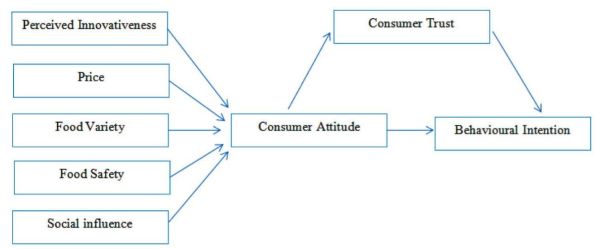
Research Methods
Research Design
The research carried out in this study is descriptive in nature. The study was carried out using the convenience sample approach to examine what influences consumer behaviour regarding cloud kitchen services in India. An online survey was conducted to test the assumptions regarding online restaurant ordering services. The popular social media including Facebook, Instagram, LinkedIn and Twitter were used to collect the required data. The respondents were students, working professionals, self-employed, businessmen and housewives. The survey made sure that only qualified individuals were accepted into the study by implementing a screening question that questioned participants if they had ever ordered meals from a cloud kitchen. As a result, it was easier to choose survey respondents who had the ability and experience with, and understanding of, cloud kitchens, potentially improving the reliability and precision of the research findings.
Sample Size
The minimum sample size was calculated via G*Power (v3.1.9.4) with the level of significance at 0.05; medium effect size (f2: 0.15); power: 0.95 (see Figure 2). According to G-Power Software, the sample size was 243.
Figure 2. G*Power Graph.
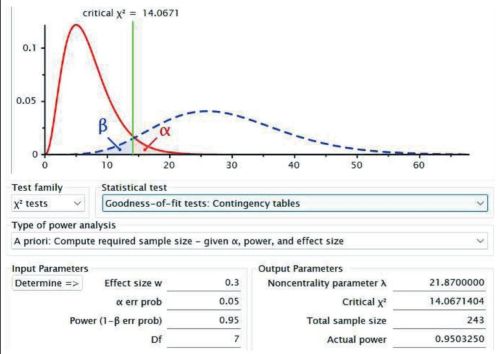
Survey Design
The present study investigates the impact of perceived innovativeness, price, social influence, food variety and food safety on consumer attitude, trust and buying intentions regarding cloud kitchen services in India. Two sections comprised the survey questionnaire. Five-point Likert scale items from ‘strongly disagreeing’ to ‘strongly agreeing’ were included as part of the initial segment. The respondents’ demographic data was gathered in the second portion. To get the participants’ opinions prior to requesting any personally identifiable information, the researchers purposefully put the demographic profile of the respondents near the bottom of the survey. This tactic can support keeping participants interested and involved across the questionnaire (Hair et al., 2016).
Reliability Analysis
The value of Cronbach’s alpha is considered to test the reliability of the scale. Table 1 indicates the reliability scores. As we can see, the value is well above the acceptable range, that is 0.70, therefore the scale is reliable.
Table 1. Operationalisation of Constructs and Reliability Analysis.
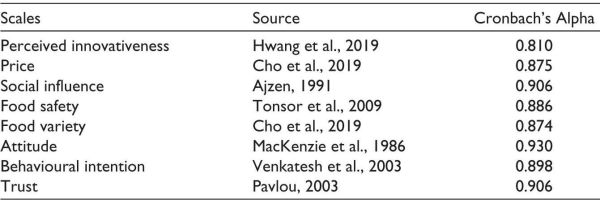
Procedural and Statistical Techniques
The current study used an exploratory methodology to look at the variables affecting customers’ intentions of using cloud kitchens. The partial least squares structural equation modelling (PLS-SEM) approach was chosen for data analysis because of the subject matter of the research question. Peng and Lai (2012) state that a minimum required sample size of 10 times the indicator count in the construction with the greatest amount of data is proposed for PLS-SEM.
Analysis and Results
Sample Profile
The study included more male participants than female, with 54.3% of the respondents identifying as male. Almost half of the participants (46.9%) were between the ages of 18–25. Furthermore, the majority of the respondents were single (77.4%) and working professionals (48.1%). Demographic characteristics are shown in Table 2.
Table 2. Demographic Characteristics of the Respondents (n = 243).
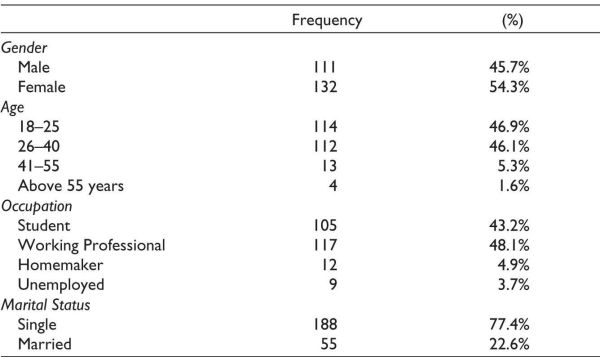
Measurement Model
The construct validity of the measurement model is tested before establishing the structural relationship. Here, Average Variance Extracted (AVE) was computed to validate the constructs’ convergence validity. Also, it can be seen in Table 3 that the constructs’ AVE values are above 0.5 as per Hair et al. (2016), demonstrating significant convergent validity. Therefore, the reliability and validity of the construct can be established.
Table 3. Construct Validity.
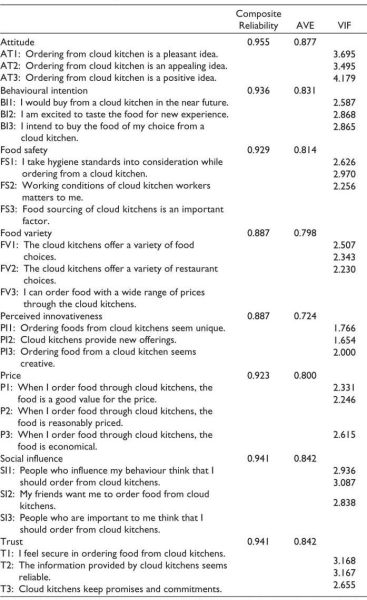
Note: AT=Attitude, BI=Behavioural intention, FS=Food safety, PI=Perceived intention, P=Price, SI=Social influence, T=Trust.
The consistency of the elements in every construct is analysed through rho A and Composite Reliability. A value of 0.7 or greater is regarded as acceptable, demonstrating that the construct’s elements are assessing the same fundamental concept. All constructs in this research had values that are significantly higher than this cutoff, ranging from 0.809 to 0.955. This shows that all the items introduced to analyse each construct are accurate and reliable.
The convergent validity of the construct, or how effectively the construct’s components reflect the same fundamental idea, is assessed using the AVE. A value of 0.5 or greater is regarded as acceptable, demonstrating that the construct’s elements are assessing the same fundamental concept. All constructs in this investigation had values that are much higher than this cutoff, ranging from 0.724 to 0.877. This shows that each construct’s components are consistently measuring the same underlying concept. According to the Fornell-Larcker Criterion, discriminant validity is being carried out. The existence of multicollinearity is typically thought to be indicated by a VIF value of 5 or above. None of the variables have a VIF value of 5 or above, as shown by the given VIF table. As a result, we can conclude that the framework does not include any substantial multicollinearity.
Table 4 reveals that all the constructs are positively correlated with each other, and the correlations are moderate to high. Attitude, Behavioural intention and Trust have the highest correlations with other constructs, ranging from 0.757 to 0.936. Perceived innovativeness and price also have moderate correlations with other constructs, ranging from 0.588 to 0.851. Food safety and Food variety have lower correlations with other constructs, ranging from 0.526 to 0.902. This suggests that these constructs are less related to other constructs but are still important in understanding the overall phenomenon.
Table 4. Fornell-Larcker Criterion, Discriminant Validity.
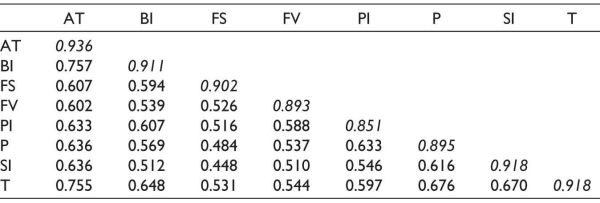
Note: AT=Attitude, BI=Behavioural intention, FS=Food safety, PI=Perceived intention, P=Price, SI=Social influence, T=Trust.
The values under 0.85 in the HTMT Model’s assessment of the strength of correlation between various variables are regarded as acceptable. Table 5 shows that there are a number of significant positive connections, including those between Behavioural intention and Attitude (0.827), Trust and Price (0.822) and Attitude and Trust (0.756). Moreover, there are some weakly positive associations, such as those between Perceived innovation and Attitude (0.729), Perceived food safety and Attitude (0.666) and Trust and Desire to act (0.717). There are also a few weakly positive connections, including those between Food variety and Attitude (0.663), Perceived innovation and Food variety (0.607) and Price and Social influence (0.689).
Table 5. Heterotrait-Monotrait Ratio (HTMT), Discriminant Validity.
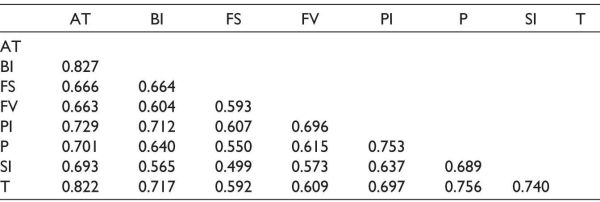
Note: AT=Attitude, BI=Behavioural intention, FS=Food safety, PI=Perceived intention, P=Price, SI=Social influence, T=Trust.
The study tested the hypotheses to examine the significance of the relationship in Table 6. The first hypothesis (H1) evaluates the relationship between perceived innovativeness and consumer attitude regarding cloud kitchens. The results revealed that there is a significant relationship between perceived innovativeness and consumer attitude regarding cloud kitchens (β = 0.172, t = 2.338 and P = .020). Hence H1 is accepted. Further, there is significant relationship between price and consumer attitude regarding cloud kitchens (β = 0.174, t = 2.594 and P = .010) and hence H2 is accepted. H3 evaluates the relationship between food variety and consumer attitude regarding cloud kitchens and which is also found to be significant (β = 0.153, t = 2.352 and P = .019). Therefore, H3 is accepted.
Table 6. Structural Relationships Testing.
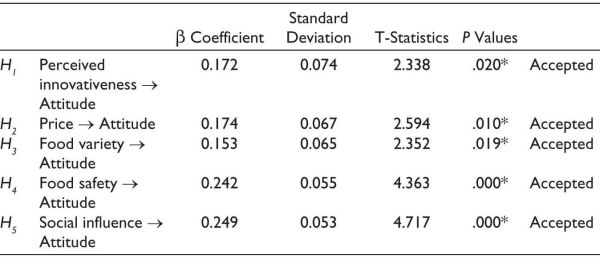
Note: *Significant at t-statistics more than 1.96 and P <. 05.
Also, there is significant relationship between food safety and consumer attitude regarding cloud kitchens (β = 0.242, t = 4.363 and P = .000). Hence H4 is accepted. Further, there exists a significant relationship between social influence and consumer attitude regarding cloud kitchens (β = 0.249, t = 4.717 and P = .000), therefore, H5 is also accepted.
Structural Model
The structural model (Figure 3) reflects the hypothesised path of the research framework. The study used R2, Q2 and path significance to assess the structural model. The study used a bootstrapping algorithm with 500 samples to examine the path coefficients’ significance. For attitude, behavioural intention and trust, the R Square values are 0.617, 0.586 and 0.570, respectively. This means that the model accounts for 61.7%, 58.6% and 57.0%, respectively, of the variation in attitude, behavioural intention and trust. The cross-validated predictive significance of the model is represented by Q Square. It evaluates how well the model can anticipate the dependent variable or variables using the independent variable as a foundation(s). The values for attitude, behavioural intention and trust in Table 7 are 0.524, 0.478 and 0.474, respectively. Although a Q Square value greater than 0.25 is often seen as acceptable, these results show that the model has moderate to strong explanatory accuracy for these constructs.
Figure 3. Structural Model.
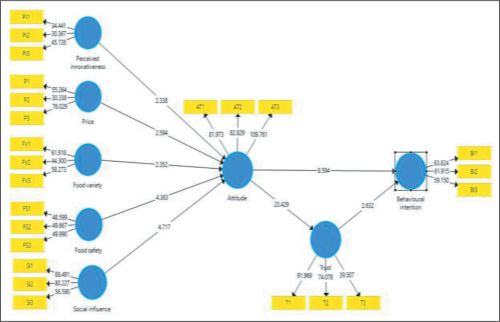
Table 7. Predictive Relevance and Coefficient of Determination.

The difference between the sample covariance matrix and the indicated covariance matrix in the model is measured by the Standardised Root Mean Square Residual (SRMR). SRMR must be lower than 0.080. Lower values of SRMR indicate a better fit. In this case, the SRMR is 0.044 for the saturated model and 0.070 for the estimated model. Therefore, the saturated model has a better fit than the estimated model (Table 8).
Table 8. Model Fitness.

Note: SRMR=Standardised root mean square residual.
Mediation Analysis
The study conducted mediation analysis to evaluate the mediating role of consumer trust on the relationship between consumer attitude and consumer behavioural intentions regarding cloud kitchens. The results of total effect and direct effect are illustrated in Table 9. The results revealed (Table 9) that the total effect of consumer attitude on consumer behavioural intentions was significant (β = 0.757, t = 18.716 and P = .000). After the inclusion of trust as a mediating variable, the impact of consumer attitude on consumer behavioural intentions is still significant (β = 0.622, t = 8.926 and P = .000).
Table 9. Total Effect and Direct Effect.

The results of the indirect effect are being listed in Table 10, which shows that the indirect effect of consumer attitude on consumer behavioural intentions was found significant (β = 0.135, t = 2.588 and P = .000). These results show that consumer trust partially mediates the relationship between consumer attitude and consumer behavioural intentions regarding cloud kitchens. Therefore, H6 is accepted.
Table 10. Specific Indirect Effect.

Discussions
The current study used an exploratory methodology to look at the variables affecting customers’ intentions of using cloud kitchens. The partial least squares structural equation modelling (PLS-SEM) approach was chosen for hypotheses testing, where all six hypotheses were found to be supported. The results revealed that consumer attitudes are positively impacted by perceived innovativeness, food variety, price, food safety and social influence. Further, consumer attitudes and behavioural intentions are significantly influenced by the mediating variable, trust, which has emphasised the need for building and sustaining consumer trust through transparency and secure privacy policies.
The findings of the present study are consistent with the existing studies where it is found that a product’s perceived innovativeness (PI) can influence how much consumers trust it (Candan et al., 2013). This is because customers are more willing to accept innovative items since they are believed to have higher epistemic worth. This result is in line with other studies such as the one by Chang (2013), which discovered that innovativeness can impact a product’s reputation and consumers’ perceptions of its reliability. It has shown that customers may be more inclined to trust and order from cloud kitchens if they perceive them to be innovative in the context of cloud kitchens. In the current study it was found that attitude has a strong positive effect on trust, which influences behavioural intention. Also, it is found that food safety is a key factor that influences consumer attitudes. Food safety, according to Ngo et al. (2023), is a highly important predictor of consumers’ attitude towards cloud kitchens. In the context of innovative services, Cheung and To (2017) discovered a positive correlation between attitude and trust. This implies that consumers form their views about a novel type of service, like cloud kitchens, based on the information they get and the perceptions they make. This result is in line with the findings of the present research, which discovered a positive correlation between trust and attitude with respect to cloud kitchens. Also, perceived innovativeness and price were found to have a strong link with consumer attitude. The finding is backed by previous studies, which show that customers are more inclined to view cloud kitchens positively if they believe them to be creative and that price has a significant impact on how consumers feel about a variety of goods and services (Choe & Kim, 2018). The study claims that the findings are in line with prior research conducted by Chotigo and Kadono (2021), Elango et al. (2018) and Muangmee et al. (2021). This supports the theory that social influence (SI) significantly affects how consumers perceive and plan to utilise cloud kitchen services. The study therefore highlights the critical function of social influence in influencing consumers’ purchasing decisions, which can be strengthened by successful advertising efforts and encouraging word-of-mouth referrals from satisfied customers (Belanche et al., 2020).
The present study is the first to pinpoint the mediating effects that trust plays. The results revealed evidence of a mediating effect, suggesting that trust may serve as a critical mediator between customers’ opinions and their behavioural intentions regarding cloud kitchens. Thus, trust has a significant impact on how customers feel about cloud kitchens, which in turn affects how likely they are to actually utilise the service.
Theoretical Implications
The present study offers a theoretical framework on cloud kitchen services in light of the growing rivalry within the food industry and the growing difficulties for businesses to reach their consumers. Moreover, by identifying the variables that has a significant effect on customer behavioural intention, the outcome of this research strengthened the foundation of knowledge already available on cloud kitchens. Further, the hypotheses explained consumer attitudes regarding cloud kitchens, which are significantly influenced by how creative they are with regard to consumers. Also, price has a substantial impact on consumers’ attitude towards cloud kitchens; economic theories such as the consumer choice theory and the price sensitivity theory may be applicable in attempting to understand customer behaviour in this situation. According to the idea of consumer choice, decisions are rationally made by customers after considering costs and benefits. According to the price sensitivity theory, customers are more likely to be price sensitive when they are less involved in the purchasing process or when there is less perceived product differentiation. Overall, there are multiple theories which can be used to elaborate consumer behaviour in the context of cloud kitchens, including variety-seeking behaviour theory, risk perception theory, social influence theory and the theory of planned behaviour.
Practical Implications
The outcome of this research has significant ramifications and provides cloud kitchen operators recommendations. First, the research model underlined the significance of trust in cloud kitchens. Operators of cloud kitchens must inform customers and foster trust in their business, especially given that the kitchen is concealed from the general public. It has been claimed that cloud kitchens provide customer features such as menu visualisation, price and nutritional data that may have an impact on trust. Social media may be used by cloud kitchen operators to interact with and establish trust of their customer base. In using food applications, social media has been proven to affect consumers’ intentions to repurchase (Yeo et al., 2017). The effect of PI, price and food variety on consumer attitude towards cloud kitchen was another significant discovery. Considering their significance, cloud kitchen operators should be offering a frictionless and engaging online user experience for customers. Customers can tune into a live video stream from the cloud kitchen to get an ‘inside peek’ at how things are done. A unique dining experience may be created by cloud kitchen operators employing ‘artificial intelligence’ and ‘machine learning’ techniques so that it can offer menu selections to customers based on their prior purchasing habits. Operators should implement techniques that make potential customers feel secure buying from them, as food safety risk plays a significant factor in influencing attitude concerning cloud kitchens. For instance, online publication of inspection results from the local health department may alleviate customer concerns about probable food safety risks. Building and sustaining consumer trust is one of the greatest strategies to boost consumer behavioural intention towards cloud kitchen. In order to positively affect attitudes and behaviours around cloud kitchen services, trust is essential. Since a transparent privacy policy may foster confidence, cloud kitchen service providers need to make a commitment to safeguarding client privacy (e.g., personal information). To foster confidence and lower risk, service providers should publish a transparent privacy policy online. Operators of cloud kitchens should invest in developing a suitable ‘persona’ for their business.
Limitations and Directions for Future Research
The current study has certain limitations. First, the study was conducted through social networking sites such as Facebook, Instagram and LinkedIn where online survey was conducted to record the opinion of users of cloud kitchen. However, we may not precisely conclude upon the findings of the study due to individual’s social desirability bias. Second, the study was conducted in India, therefore the results are not generalisable to the rest of the world. Third, the study is an outcome of the online survey which was conducted at a point of time with a set of respondents which were available on these social networking sites during the survey period. This gives a possibility of missing out of few important responses. The findings of the study will pave the way for future researches. To give more insights, a cross-cultural study can be conducted within India to compare the impact of multiple cultures on the behavioural intention towards cloud kitchen. The study can be further extended across the border to compare the attitude and intentions between two countries or continents. Further, to validate the findings of the study a mixed method approach can be adopted.
Declaration of Conflicting Interests
The authors declared no potential conflicts of interest with respect to the research, authorship and/or publication of this article.
Funding
The authors received no financial support for the research, authorship and/or publication of this article.
ORCID iDs
Saurabh Verma  https://orcid.org/0000-0002-9816-1552
https://orcid.org/0000-0002-9816-1552
Sunil Kumar Yadav  https://orcid.org/0000-0003-4671-6357
https://orcid.org/0000-0003-4671-6357
Agarwal, R., & Prasad, J. (1997). The role of innovation characteristics and perceived voluntariness in the acceptance of information technologies. Decision Sciences, 28(3), 557–582.
Ajzen, I. (1991). The theory of planned behavior. Organizational behavior and Human Decision Processes, 50(2), 179–211.
Barkhi, R., & Wallace, L. (2007). The impact of personality type on purchasing decisions in virtual stores. Information Technology and Management, 8, 313–330.
Becerra, E. P., & Korgaonkar, P. K. (2011). Effects of trust beliefs on consumers’ online intentions. European Journal of Marketing, 45(6), 936–962.
Belanche, D., Flavian, M., & Perez-Rueda, A. (2020). Mobile apps use and WOM in the food delivery sector: The role of planned behavior, perceived security and customer lifestyle compatibility. Sustainability, 12(10), 4275.
Brucks, M., Zeithaml, V. A., & Naylor, G. (2000). Price and brand name as indicators of quality dimensions for consumer durables. Journal of the Academy of Marketing Science, 28, 359–374.
Cai, R., Leung, X. Y., & Chi, C. G. Q. (2022). Ghost kitchens on the rise: Effects of knowledge and perceived benefit-risk on customers’ behavioral intentions. International Journal of Hospitality Management, 101, 103110.
Candan, B., Ünal, S., & Erci.png) , A. (2013). Analysing the relationship between consumption values and brand loyalty of young people: A study on personal care products. Management, 29, 46.
, A. (2013). Analysing the relationship between consumption values and brand loyalty of young people: A study on personal care products. Management, 29, 46.
Chan, K. H., Lee, P. W., Chan, C. Y., Lam, K. B. H., & Ho, P. L. (2020). Monitoring respiratory infections in COVID-19 epidemics. BMJ, 369, 1–8.
Chandrasekhar, N., Gupta, S., & Nanda, N. (2019). Food delivery services and customer preference: A comparative analysis. Journal of Foodservice Business Research, 22(4), 375–386.
Chang, K. C. (2013). How reputation creates loyalty in the restaurant sector. International Journal of Contemporary Hospitality Management, 25(4), 536–557.
Chatterjee, R., Singh, A., & Singh, V. (2022). Ethical and sustainable perceptions on cloud kitchen business: A study of consumers and stakeholders during the COVID-19 pandemic. International Journal of Hospitality and Tourism Systems, 15(COVID-19 Issue), 76.
Chen, L. D., & Tan, J. (2004). Technology adaptation in e-commerce: Key determinants of virtual stores acceptance. European Management Journal, 22(1), 74–86.
Chen, M. F. (2008). Consumer trust in food safety: A multidisciplinary approach and empirical evidence from Taiwan. Risk Analysis: An International Journal, 28(6), 1553–1569.
Cheung, M. F., & To, W. M. (2017). The influence of the propensity to trust on mobile users’ attitudes toward in-app advertisements: An extension of the theory of planned behavior. Computers in Human Behavior, 76, 102–111.
Chhabra, N., & Rana, A. (2021). Rise and the future of cloud kitchens in India: A consumer study. International Journal of Research in Engineering, Science and Management, 4(7), 158–165.
Chiu, C. M., Chang, C. C., Cheng, H. L., & Fang, Y. H. (2009). Determinants of customer repurchase intention in online shopping. Online Information Review, 33(4), 761–784.
Cho, M., Bonn, M. A., & Li, J. J. (2019). Differences in perceptions about food delivery apps between single-person and multi-person households. International Journal of Hospitality Management, 77, 108–116.
Choe, J. Y. J., & Kim, S. S. (2018). Effects of tourists’ local food consumption value on attitude, food destination image, and behavioral intention. International Journal of Hospitality Management, 71, 1–10.
Choi, K., Wang, Y., & Sparks, B. (2019). Travel app users’ continued use intentions: It’s a matter of value and trust. Journal of Travel & Tourism Marketing, 36(1), 131–143.
Chotigo, J., & Kadono, Y. (2021). Comparative analysis of key factors encouraging food delivery app adoption before and during the COVID-19 pandemic in Thailand. Sustainability, 13(8), 4088.
Choudhary, N. (2019). Strategic analysis of cloud kitchen: A case study. Management Today, 9(3), 184–190.
Davis, F. D. (1989). Perceived usefulness, perceived ease of use, and user acceptance of information technology. MIS Quarterly, 13(3), 319–340.
Dwivedi, Y. K., Rana, N. P., Jeyaraj, A., Clement, M., & Williams, M. D., (2019). Re-examining the unified theory of acceptance and use of technology (UTAUT): Towards a revised theoretical model. Information Systems Frontiers, 21, 719–734.
Elango, D., Dowpiset, K., & Chantawaranurak, J. (2018, August 24). A study on factors impacting consumers’ intention to use on-demand food delivery applications in Bangkok, Thailand. 1–19. http://dx.doi.org/10.2139/ssrn.3321587
Farah, M. F., Ramadan, Z., & Kanso, J. (2022). Satisfying the online food crave: The case of online food aggregators. International Journal of Consumer Studies, 46(4), 1413–1427.
Fishbein, M., & Ajzen, I. (1977). Belief, attitude, intention, and behavior: An introduction to theory and research.
Frewer, L., de Jonge, J., & van Kleef, E. (2009). Consumer perceptions of food safety. Medical Science, 2, 243.
Gass, R. H., & Seiter, J. S. (2022). Persuasion: Social influence and compliance gaining (7th ed.). Routledge.
Ha, T. M., Shakur, S., & Do, K. H. P. (2020). Linkages among food safety risk perception, trust and information: Evidence from Hanoi consumers. Food Control, 110, 06965.
Hair, Jr, J. F., Sarstedt, M., Matthews, L. M., & Ringle, C. M. (2016). Identifying and treating unobserved heterogeneity with FIMIX-PLS: Part I–method. European Business Review, 28(1), 63–76.
Hamid, S., & Azhar, M. (2023). Behavioral intention to order food and beverage items using e-commerce during COVID-19: An integration of theory of planned behavior (TPB) with trust. British Food Journal, 125(1), 112–131.
Hwang, J., Lee, J.S., & Kim, H. (2019). Perceived innovativeness of drone food delivery services and its impacts on attitude and behavioral intentions: The moderating role of gender and age. International Journal of Hospitality Management, 81, 94–103.
Idris, N. S., Zulkifly, M. A., Safuan, M., & Latip, A. (2023). New trends of cloud kitchen technology and consumers’ purchase decisions: A conceptual study. Voice of Academia, 19(2), 114–126.
Jiang, Y., Balaji, M. S., & Lyu, C. (2024). Cultivating initial trust in ghost kitchens: A mixed-methods investigation of antecedents and consequences. International Journal of Hospitality Management, 119, 103727.
Khan, T. A., Khan, S. A., Haque, S., & Ayub, M. F. B. (2023). A study on the prospect of the cloud kitchen model in Dhaka. International Journal of Business and Management, 18(1), 46–59.
Konuk, F. A. (2019). The impact of retailer innovativeness and food healthiness on store prestige, store trust and store loyalty. Food Research International, 116, 724–730.
Koththagoda, K. C., & Herath, H. M. R. P. (2018). Factors influencing online purchasing intention: The mediation role of consumer attitude. Journal of Marketing and Consumer Research, 42(2003), 66–74.
Kulshreshtha, K., & Sharma, G. (2022). From restaurant to cloud kitchen: Survival of the fittest during COVID-19 an empirical examination. Technological Forecasting and Social Change, 179, 121629.
Levyda, L. (2017). What values are perceived by hotel guests? International Journal of Services, Economics and Management, 8(1–2), 73–89.
Lim, K. B., Yeo, S. F., Tan, C. L., & Wen, W. W. (2022). Impact of social media on consumer purchase behaviour during COVID-19 pandemic. International Journal of Entrepreneurship, Business and Creative Economy, 2(1), 23–36.
Luo, L., Ni, J., Zhou, M., Wang, C., Wen, W., Jiang, J., Cheng, Y., Zhang, X., Wang, M., & Wang, W. (2021). Food safety knowledge, attitudes, and self-reported practices among medical staff in China before, during and after the COVID-19 pandemic. Risk Management and Healthcare Policy, 14(1), 5027–5038.
Ma, L., Chen, H., Yan, H., Wu, L., & Zhang, W. (2019). Food safety knowledge, attitudes, and behavior of street food vendors and consumers in Handan, a third-tier city in China. BMC Public Health, 19(1), 1–13.
MacKenzie, S. B., Lutz, R. J., & Belch, G. E. (1986). The role of attitude toward the ad as a mediator of advertising effectiveness: A test of competing explanations. Journal of marketing research, 23(2), 130–143.
Mathur, P., & Mathur, V. K. (2023). Consumer purchase intention and behavior toward cloud kitchen (pandemic opportunity) with reference to India: An empirical examination. Jindal Journal of Business Research, 12(2), 194–208.
Monroe, K. B., & Petroshius, S. M. (1981). Buyers’ perceptions of price: An update of the evidence. Perspectives in Consumer Behavior, 3(23), 43–55.
Muangmee, C., Kot, S., Meekaewkunchorn, N., Kassakorn, N., & Khalid, B. (2021). Factors determining the behavioral intention of using food delivery apps during COVID-19 pandemics. Journal of Theoretical and Applied Electronic Commerce Research, 16(5), 1297–1310.
Naderi, I., & Paswan, A. K. (2016). Narcissistic consumers in retail settings. Journal of Consumer Marketing, 33(5), 376–386.
Nardi, V. A. M., Teixeira, R., Ladeira, W. J., & de Oliveira Santini, F. (2020). A meta-analytic review of food safety risk perception. Food Control, 112, 107089.
Ngo, H. M., Liu, R., Moritaka, M., & Fukuda, S. (2023). Determinants of consumer intention to purchase food with safety certifications in emerging markets: Evidence from Vietnam. Journal of Agribusiness in Developing and Emerging Economies, 13(2), 243–259.
Nigro, C., Iannuzzi, E., di Santo, N., & Sisto, R. (2023). Food delivery, ghost kitchens and virtual restaurants: Temporary or long-lasting game changers? British Food Journal, 125(6), 2217–2233.
Oentoro, W. (2021). Mobile payment adoption process: A serial of multiple mediation and moderation analysis. The Bottom Line, 34(3/4), 225–244.
Oliver, R. L., Rust, R. T., & Varki, S. (1997). Customer delight: Foundations, findings, and managerial insight. Journal of Retailing, 73(3), 311–336.
Olya, H. G., & Al-Ansi, A. (2018). Risk assessment of halal products and services: Implication for tourism industry. Tourism Management, 65, 279–291.
Othman, M. S., Nor, N. M., & Rosdi, W. N. W. (2021). Impact of ghost kitchen towards consumer behavioral intention during movement control order. Journal of Islamic, Social, Economics and Development, 6(36), 30–37.
Park, E., & Kim, K. J. (2013). User acceptance of long-term evolution (LTE) services: An application of extended technology acceptance model. Program, 47(2), 188–205.
Pavlou, P. A. (2003). Consumer acceptance of electronic commerce: Integrating trust and risk with the technology acceptance model. International Journal of Electronic Commerce, 7(3), 101–134.
Peng, D. X., & Lai, F. (2012). Using partial least squares in operations management research: A practical guideline and summary of past research. Journal of operations management, 30(6), 467–480.
Perrea, T., Grunert, K. G., & Krystallis, A. (2015). Consumer value perceptions of food products from emerging processing technologies: A cross-cultural exploration. Food Quality and Preference, 39, 95–108.
Pine, B. J., & Gilmore, J. H. (1998). Welcome to the experience economy. Harvard Business Review, 76(4), 97–105.
Rana, J., & Paul, J. (2017). Consumer behavior and purchase intention for organic food: A review and research agenda. Journal of Retailing and Consumer Services, 38, 157–165.
Roosen, J., Bieberstein, A., Blanchemanche, S., Goddard, E., Marette, S., & Vandermoere, F. (2015). Trust and willingness to pay for nanotechnology food. Food Policy, 52, 75–83.
Saberian, F., Amirshahi, M., Ebrahimi, M., & Nazemi, A. (2020). Linking digital platforms’ service dimensions to customers’ purchase. The Bottom Line, 33(4), 315–335.
Sanny, L., Hamada, A., Prameswari, A., & Setiawan, A. (2022, September). Effects of social media marketing in cloud kitchen towards online platform in Indonesia. In 2022 International Seminar on Application for Technology of Information and Communication (iSemantic) (pp. 367–371). IEEE.
Sarbhai, A., & Khare, V. (2023). Post pandemic shift of consumer behavior & cloud kitchen. International Journal for Research in Applied Science & Engineering Technology, 11(7), 1992–2002.
Sheth, J. N., Newman, B. I., & Gross, B. L. (1991). Why we buy what we buy: A theory of consumption values. Journal of business research, 22(2), 159–170.
Silva, M. J. D. B., Farias, S. A. D., & Silva, C. J. (2023). Endorsement on Instagram and cultural dimensions: An analysis of digital influencers. The Bottom Line, 36(1), 1–28.
Simonson, I., & Tversky, A. (1992). Choice in context: Tradeoff contrast and extremeness aversion. Journal of Marketing Research, 29(3), 281–295.
Suki, N. M. (2016). Consumer environmental concern and green product purchase in Malaysia: Structural effects of consumption values. Journal of Cleaner Production, 132, 204–214.
Talwar, S., Kaur, P., Ahmed, U., Bilgihan, A., & Dhir, A. (2023). The dark side of convenience: How to reduce food waste induced by food delivery apps. British Food Journal, 125(1), 205–225.
Teng, W. (2019). Utilitarian, hedonic, collecting, epistemic, and high values as determinants of the attractiveness of premium promotions. Journal of Marketing Communications, 25(6), 626–644.
Ter Ji-Xi, J., Salamzadeh, Y., & Teoh, A. P. (2021). Behavioral intention to use cryptocurrency in Malaysia: An empirical study. The Bottom Line, 34(2), 170–197.
Tonsor, G. T., Schroeder, T. C., & Pennings, J. M. (2009). Factors impacting food safety risk perceptions. Journal of Agricultural Economics, 60(3), 625–644.
Troise, C., O’Driscoll, A., Tani, M., & Prisco, A. (2021). Online food delivery services and behavioural intention: A test of an integrated TAM and TPB framework. British Food Journal, 123(2), 664–683.
Tualeka, S. H. (2024). Multi-brand virtual restaurant: Cloud kitchen business model (case study of PT. Sagala). Management Studies and Entrepreneurship Journal (MSEJ), 5(2), 4921–4931.
Venkatesh, V., Morris, M. G., Davis, G. B., & Davis, F. D. (2003). User acceptance of information technology: Toward a unified view. MIS Quarterly, 27(3), 425–478.
Völckner, F., & Hofmann, J. (2007). The price-perceived quality relationship: A meta-analytic review and assessment of its determinants. Marketing Letters, 18, 181–196.
Watanabe, E. A. D. M., Alfinito, S., Curvelo, I. C. G., & Hamza, K. M. (2020). Perceived value, trust and purchase intention of organic food: A study with Brazilian consumers. British Food Journal, 122(4), 1070–1184.
Wu, C., Tao, Y. H., & Lin, Y. M. (2017). Repurchase decision for music products in Taiwan: Physical versus online media. Digital Policy, Regulation and Governance, 19(4), 302–316.
Yeo, V. C. S., Goh, S. K., & Rezaei, S. (2017). Consumer experiences, attitude and behavioral intention toward online food delivery (OFD) services. Journal of Retailing and Consumer services, 35, 150–162.
Youn, H., & Kim, J. H. (2018). Is unfamiliarity a double-edged sword for ethnic restaurants? International Journal of Hospitality Management, 68, pp. 23–31.
Zhu, D. S., Chih, Z., O’Neal, G. S., & Chen, Y. H. (2011). Mr. Risk! Please trust me: Trust antecedents that increase online consumer purchase intention. Journal of Internet Banking and Commerce, 16(3), 1